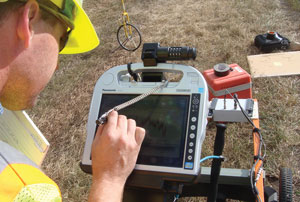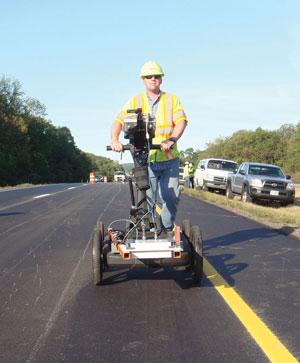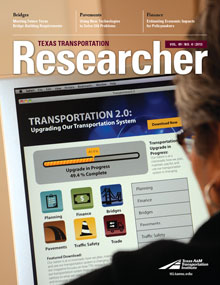TTI-Developed Rolling Density Meter Detects Mix-Density Problems
Most of the premature failures in asphalt pavement can be traced back to construction problems that resulted in large variations in mix density. Too-low- or too-high-density asphalt mixes can lead to all kinds of problems that are costly to repair.

“Historically, the way to test a new pavement for the proper mix density was by using spot-specific measurements. This could be taking localized nuclear density readings or taking core samples and measuring their density in the laboratory. It was very labor intensive,” Tom Scullion, manager of TTI‘s Flexible Pavements Program, explains. “Because samples could not be taken everywhere, we could miss defects, and the roads were failing in places we did not test.”
With the goal of building defect-free pavements, TTI researchers needed a way to test the entirety of the newly paved road. Scullion, who advanced the use of ground- penetrating radar (GPR) years ago to determine the hidden causes of road failures, turned to GPR as a way to solve the density-testing dilemma.
“We worked with a GPR manufacturer and told them what we were trying to accomplish,” TTI Associate Research Scientist Stephen Sebesta says. “Eventually, they determined a new testing device could be built. The result is what we call the rolling density meter.”

Currently the rolling density meter is pushed by hand down the new road, and onboard radar emits an electrical magnetic pulse into the pavement. The mix density is measured instantly in a continuous one-step procedure. Sebesta says several of the rolling density meters can be mounted on a vehicle and simply driven over new sections of pavement in a single pass.
The new rolling density meter device was tested in four states as part of the Strategic Highway Research Program 2 (SHRP2) project titled Using Infrared and Ground Penetrating Radar for Uniformity Measurement on New HMA Layers. Testing showed the device to be accurate and reliable, and it’s expected to be showcased at the 2014 Transportation Research Board Annual Meeting. Also, it was ranked this year by the American Association of State Highway and Transportation Officials as the most valuable product of SHRP2.
“Based on its performance thus far, I really expect that rolling density meters could eventually become part of the specifications for road projects across the country,” Scullion says.
Innovative Device Identifies Defects Within Concrete Pavement
Another breakthrough in pavement testing has been developed through a joint effort of TTI, the Texas Department of Transportation, the Center for Transportation Research at The University of Texas and Industrial Vehicles International. The total pavement acceptance device (TPAD) — also known as the rolling dynamic deflectometer — is now being used to identify defects within concrete pavements.

The TPAD integrates a deflection-measuring system with GPR and high-definition video. Deflections are measured by three rolling geophones under a vibratory load applied at a frequency of 30 Hz. Data-processing systems developed by TTI integrate all these data and present designers with deflection data measurements approximately every 2 inches of travel. The TPAD can, therefore, measure the load transfer efficiency of every joint or crack in a concrete pavement as well as the quality of pavement support — critical factors in the pavement evaluation process.
“What we did was combine two very useful technologies on one platform,” TxDOT Pavement Structural Engineer Joe Leidy explains. “The TPAD is a very large machine driven along a roadway [at 3 miles per hour] that collects rolling deflection data coupled with GPR readings. The machine is also equipped with a high-definition video camera and GPS.”
For the first time, Leidy says, a comprehensive evaluation can be made giving engineers the ability to make relevant decisions about rehabilitation strategies. He says it’s possible that the TPAD could be used to detect problems in other types of pavements as well.
Researchers say the TPAD‘s success has caught the attention of the U.S. government and could soon be used to evaluate military runways.
“The TPAD is a great example of how innovation can help solve problems,” Sebesta points out. “It’s also an example of how various entities and the private sector can work together to make important improvements where the real winner is the taxpayer.”
